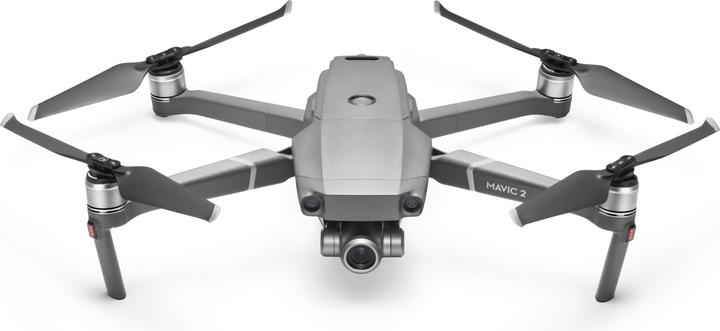

DJI takes the next step with the Mavic 2 Pro and Mavic 2 Zoom
DJI has redesigned its Mavic drones from every angle, with the sole aim of producing better quality photos and videos. Here are the details.
DJI has presented two new drones to the public: the Mavic 2 Pro and the Mavic 2 Zoom. Only the camera differentiates these two drones, the flight characteristics and structure are identical.
Best cameras
The DJI Mavic Pro is equipped with a Hasselblad camera. With a one-inch CMOS sensor and f/2.8 light intensity, it should capture great images in the dark. For bright environments such as a snowy landscape in the sunshine, the focal length can be reduced to f/11. This is a standard feature for cameras, but still rare on drones. The variable focal aperture allows longer exposure times in a bright environment and smoother movements. In full format, the focal length is 28 mm. For professional videos, the camera supports a 10-bit D-Log colour profile. The drone can be connected to a 4K TV with HLG and play back 10-bit content with the correct colour tones.

The Mavic 2 Zoom primarily allows you to get as close to the action as possible. It has an optical zoom camera, which is not common on drones. The focal length ranges from 24 to 48 millimetres, and there's also a 96 mm digital zoom. Nine photos can be merged into a single 48-megapixel image. Thanks to its exceptional zoom, the Mavic 2 Zoom is also capable of producing an effect known as "Dolly Zoom" or contrarian travelling.

For the zoom dolly, as the camera zooms in, the drone moves in the opposite direction and at a different speed. It was Alfred Hitchcock's film Vertigo that made this effect famous, in which it is used to visualise the sensation of vertigo.
Both cameras use DJI's three-axis gimbal for maximum shot stabilisation, offer a maximum bit rate of 100 mbit/s and support the H.265 codec. The drones also feature HDR.
Time passing in flight
Now that the general public has got used to drones, it's much harder to impress them. DJI's answer is hyperlapse, where photos are automatically processed and recorded. Time-lapse films are literally made in the moment, without the need for a computer. The drones also have several automatic flight modes: free flight, circle, trajectory readjustment and way point. They can fly around a point or past it, and this type of trajectory can be recorded for later shots.

Improved target tracking
DJI has developed a new and improved tracking feature, dubbed Active Trac 2.0. The new system - which relies not only on the main camera, but also on the two optical sensors for its calculations - can therefore establish a 3D model, whereas its predecessor only provided a 2D rendering. Trajectory prediction helps maintain tracking, even when the object is temporarily hidden.
Faster, longer and quieter flights
DJI's new drones enable longer, faster and quieter flights than their predecessor. The battery should now last up to 31 minutes thanks to improved aerodynamics, but this figure only applies when there is no wind. The drones can keep up a good pace of 70km/h and the live image can be transmitted up to a distance of 8km.
Optical obstacle avoidance sensors are placed not only at the front and rear, but also under the drone and on the sides. The Advanced Pilot Assistance System (APAS) that enables the aircraft to avoid obstacles has also been improved by DJI. The drones are also equipped with a downward-illuminating LED for flights in the dark. The flight information system also provides valuable assistance by automatically avoiding prohibited areas such as airports.
Last but not least: the drones have 8GB of internal memory. Handy if all your memory cards are ever full or faulty.
My interest in IT and writing landed me in tech journalism early on (2000). I want to know how we can use technology without being used. Outside of the office, I’m a keen musician who makes up for lacking talent with excessive enthusiasm.
